
Jehu was the tenth king of the northern Kingdom of Israel since Jeroboam I, noted for exterminating the house of Ahab. He was the son of Jehoshaphat, grandson of Nimshi, and possibly great-grandson of Omri, although the latter notion is not supported by the biblical text. His reign lasted for 28 years.
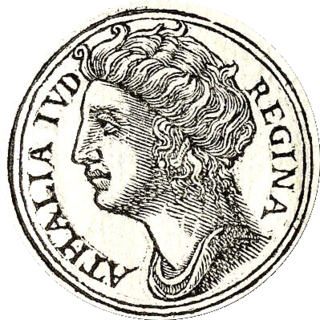
Athaliah was the daughter of either king Omri, or of King Ahab and Queen Jezebel of Israel, the queen consort of Judah as the wife of King Jehoram, a descendant of King David, and later queen regnant c. 841–835 BCE.
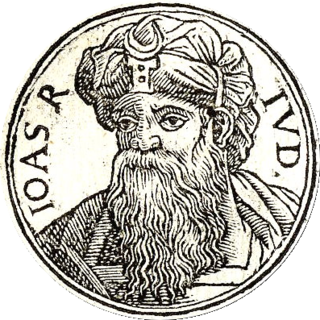
Jehoash, also known as Joash, Joas or Joás, was the eighth king of Judah, and the sole surviving son of Ahaziah after the massacre of the royal family ordered by his grandmother, Athaliah. His mother was Zibiah of Beersheba. Jehoash was 7 years old when his reign began, and he reigned for 40 years. He was succeeded by his son, Amaziah of Judah. He is said to have been righteous "all the days of Jehoiada the priest" but to have deviated from fidelity to Yahweh after Jehoiada's death.
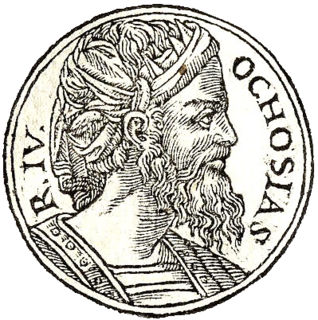
Ahaziah of Judah or Jehoahaz I, was the sixth king of Judah, and the son of Jehoram and Athaliah, the daughter of king Ahab of Israel. He was also the first Judahite king to be descended from both the House of David and the House of Omri, through his mother and successor, Athaliah.
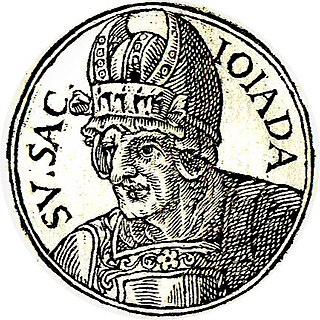
Jehoiada in the Hebrew Bible, was a prominent priest in the kingdom of Judah during the reigns of Ahaziah, Athaliah, and Joash. Jehoiada became the brother-in-law of King Ahaziah as a result of his marriage with princess Jehosheba. Both Jehosheba and Ahaziah were children of King Jehoram of Judah. Ahaziah died a year after assuming the throne, which was then usurped by his mother Athaliah, who ordered the execution of all members of the royal family.

The Omrides, Omrids or House of Omri were a ruling dynasty of the Kingdom of Israel (Samaria) founded by King Omri. According to the Bible, the Omride rulers of Israel were Omri, Ahab, Ahaziah and Jehoram. Ahab's daughter Athaliah also became queen regnant of the Kingdom of Judah.

Jehosheba, or Josaba, is a figure in the Hebrew Bible. She was the daughter of King Jehoram of Judah, sister to King Ahaziah of Judah and wife of Jehoiada the priest. She was a daughter of Jehoram, but not necessarily of Athaliah. After the death of Ahaziah, his mother, Athaliah, made herself Queen of Judah and ordered the execution of all members of the royal family that could claim the throne. However, according to 2 Kings 11:2, Jehosheba saved from the massacre her infant nephew Jehoash, Ahaziah's son and Athaliah's grandson:
But Jehosheba, the daughter of king Joram, sister of Ahaziah, took Joash the son of Ahaziah, and stole him from among the king's sons which were slain; and they hid him, even him and his nurse, in the bedchamber from Athaliah, so that he was not slain.

Hosea 1 is the first chapter of the Book of Hosea in the Hebrew Bible or the Old Testament of the Christian Bible. This book contains the prophecies attributed to the prophet Hosea son of Beeri, and this chapter especially sets forth the spiritual whoredom of Israel by symbolical acts. It is a part of the Book of the Twelve Minor Prophets.
The House of Jehu or Jehu dynasty was a reigning dynasty of the Kingdom of Israel. They are depicted in both of the Books of Kings. Their estimated reign is placed from the 9th century to the 8th century BCE.

2 Kings 3 is the third chapter in the second part of the Books of Kings in the Hebrew Bible or the Second Book of Kings in the Old Testament of the Christian Bible. The book is a compilation of various annals recording the acts of the kings of Israel and Judah by a Deuteronomic compiler in the seventh century BCE, with a supplement added in the sixth century BCE. After a short introduction to the reign of the last king of Israel from the Omride dynasty, Jehoram the son of Ahab, this chapter records the war of the coalition of the kings of Israel, Judah, and Edom, against Mesha the king of Moab with some contribution of Elisha the prophet. Another view of the events in this chapter is notably provided by the inscription on the Mesha Stele made by the aforementioned king of Moab in c. 840 BCE.

2 Kings 1 is the first chapter of the second part of the Books of Kings in the Hebrew Bible or the Second Book of Kings in the Old Testament of the Christian Bible. The book is a compilation of various annals recording the acts of the kings of Israel and Judah by a Deuteronomic compiler in the seventh century BCE, with a supplement added in the sixth century BCE. This chapter focuses on the Israel king Ahaziah, the son of Ahab, and the acts of Elijah the prophet who rebuked the king and prophesied the king's death.

2 Kings 8 is the eighth chapter of the second part of the Books of Kings in the Hebrew Bible or the Second Book of Kings in the Old Testament of the Christian Bible. The book is a compilation of various annals recording the acts of the kings of Israel and Judah by a Deuteronomic compiler in the seventh century BCE, with a supplement added in the sixth century BCE. This chapter records Elisha's acts in helping the family of Shunammite woman to escape famine, then to gain back their land and in contributing to Hazael's ascension to the throne of Syria (Aram) in verses 7–15; then subsequently records the reigns of Joram and Ahaziah, the kings of Judah.

2 Kings 9 is the ninth chapter of the second part of the Books of Kings in the Hebrew Bible or the Second Book of Kings in the Old Testament of the Christian Bible. The book is a compilation of various annals recording the acts of the kings of Israel and Judah by a Deuteronomic compiler in the seventh century BCE, with a supplement added in the sixth century BCE. This chapter records Jehu's anointing as the next king of Israel and his assassinations of Jehoram the king of Israel, Ahaziah the king of Judah and Jezebel the queen mother of Israel. The narrative is a part of a major section 2 Kings 9:1–15:12 covering the period of Jehu's dynasty.

2 Kings 10 is the tenth chapter of the second part of the Books of Kings in the Hebrew Bible or the Second Book of Kings in the Old Testament of the Christian Bible. The book is a compilation of various annals recording the acts of the kings of Israel and Judah by a Deuteronomic compiler in the seventh century BCE, with a supplement added in the sixth century BCE. This chapter records Jehu's massacres of the sons of Ahab, the kinsmen of Ahaziah the king of Judah and the Baal worshippers linked to Jezebel. The narrative is a part of a major section 2 Kings 9:1–15:12 covering the period of Jehu's dynasty.

2 Kings 13 is the thirteenth chapter of the second part of the Books of Kings in the Hebrew Bible or the Second Book of Kings in the Old Testament of the Christian Bible. The book is a compilation of various annals recording the acts of the kings of Israel and Judah by a Deuteronomic compiler in the seventh century BCE, with a supplement added in the sixth century BCE. This chapter records the reigns of Jehu's son, Jehoahaz, and Jehu's grandson, Jehoash, in the kingdom of Israel during the reign of Jehoash, the king of Judah, as well as the events around the death of Elisha. The narrative is a part of a major section 2 Kings 9:1–15:12 covering the period of Jehu's dynasty.

1 Kings 22 is the 22nd chapter of the First Book of Kings in the Old Testament of the Christian Bible or the first part of Books of Kings in the Hebrew Bible. The book is a compilation of various annals recording the acts of the kings of Israel and Judah by a Deuteronomic compiler in the seventh century BCE, with a supplement added in the sixth century BCE. This chapter belongs to the section comprising 1 Kings 16:15 to 2 Kings 8:29 which documents the period of Omri's dynasty. The focus of this chapter is the reign of king Ahab and Ahaziah in the northern kingdom, as well as of king Jehoshaphat in the southern kingdom.

2 Kings 12 is the twelfth chapter of the second part of the Books of Kings in the Hebrew Bible or the Second Book of Kings in the Old Testament of the Christian Bible. The book is a compilation of various annals recording the acts of the kings of Israel and Judah by a Deuteronomic compiler in the seventh century BCE, with a supplement added in the sixth century BCE. This chapter records the reign of Joash as the king of Judah.
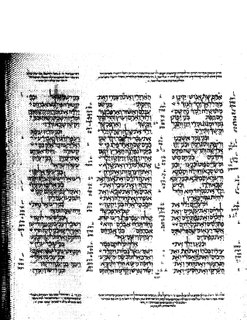
2 Chronicles 22 is the twenty-second chapter of the Second Book of Chronicles the Old Testament in the Christian Bible or of the second part of the Books of Chronicles in the Hebrew Bible. The book is compiled from older sources by an unknown person or group, designated by modern scholars as "the Chronicler", and had the final shape established in late fifth or fourth century BCE. This chapter belongs to the section focusing on the kingdom of Judah until its destruction by the Babylonians under Nebuchadnezzar and the beginning of restoration under Cyrus the Great of Persia. The focus of this chapter is the reigns of Ahaziah and Athaliah, rulers of Judah.

2 Chronicles 23 is the twenty-third chapter of the Second Book of Chronicles the Old Testament in the Christian Bible or of the second part of the Books of Chronicles in the Hebrew Bible. The book is compiled from older sources by an unknown person or group, designated by modern scholars as "the Chronicler", and had the final shape established in late fifth or fourth century BCE. This chapter belongs to the section focusing on the kingdom of Judah until its destruction by the Babylonians under Nebuchadnezzar and the beginning of restoration under Cyrus the Great of Persia. The focus of this chapter is the reigns of Athaliah and Joash, rulers of Judah.

1 Kings 16 is the sixteenth chapter of the Books of Kings in the Hebrew Bible or the First Book of Kings in the Old Testament of the Christian Bible. The book is a compilation of various annals recording the acts of the kings of Israel and Judah by a Deuteronomic compiler in the seventh century BCE, with a supplement added in the sixth century BCE. This chapter belongs to the section comprising 1 Kings 12:1 to 16:14 which documents the consolidation of the kingdoms of northern Israel and Judah. The focus of this chapter is the reigns Baasha, Elah, Zimri, Omri and Ahab in the northern kingdom during the reign of Asa in the southern kingdom.











